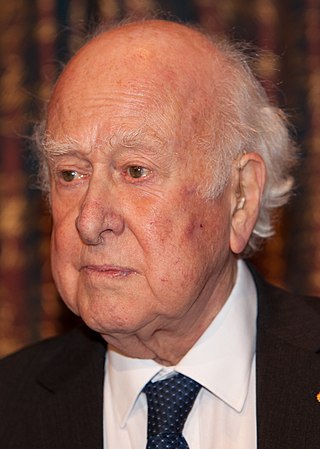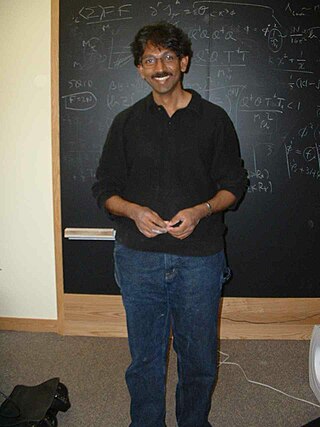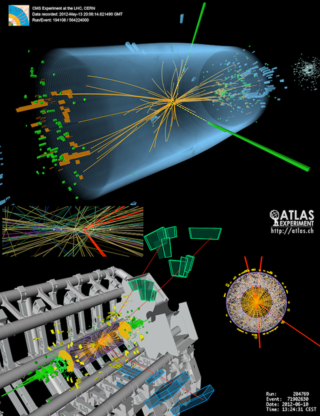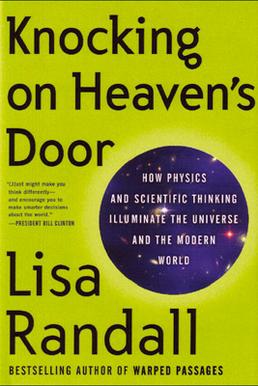In physics, the fundamental interactions or fundamental forces are the interactions that do not appear to be reducible to more basic interactions. There are four fundamental interactions known to exist:

In particle physics, an elementary particle or fundamental particle is a subatomic particle that is not composed of other particles. The Standard Model presently recognizes seventeen distinct particles—twelve fermions and five bosons. As a consequence of flavor and color combinations and antimatter, the fermions and bosons are known to have 48 and 13 variations, respectively. Among the 61 elementary particles embraced by the Standard Model number: electrons and other leptons, quarks, and the fundamental bosons. Subatomic particles such as protons or neutrons, which contain two or more elementary particles, are known as composite particles.

Particle physics or high-energy physics is the study of fundamental particles and forces that constitute matter and radiation. The field also studies combinations of elementary particles up to the scale of protons and neutrons, while the study of combination of protons and neutrons is called nuclear physics.

Peter Ware Higgs was a British theoretical physicist, professor at the University of Edinburgh, and Nobel laureate in Physics for his work on the mass of subatomic particles.
In physics, Randall–Sundrum models are models that describe the world in terms of a warped-geometry higher-dimensional universe, or more concretely as a 5-dimensional anti-de Sitter space where the elementary particles are localized on a (3 + 1)-dimensional brane or branes.

In theoretical physics, the hierarchy problem is the problem concerning the large discrepancy between aspects of the weak force and gravity. There is no scientific consensus on why, for example, the weak force is 1024 times stronger than gravity.

Warped Passages: Unraveling the Mysteries of the Universe's Hidden Dimensions is the debut non-fiction book by Lisa Randall, published in 2005, about particle physics in general and additional dimensions of space in particular. The book has made it to top 50 at amazon.com, making it the world's first successful book on theoretical physics by a female author. She herself characterizes the book as being about physics and the multi-dimensional universe. The book describes, at a non-technical level, theoretical models Professor Randall developed with the physicist Raman Sundrum, in which various aspects of particle physics are explained in a higher-dimensional braneworld scenario. These models have since generated thousands of citations.

Maria Spiropulu is a Greek particle physicist. She is the Shang-Yi Ch'en Professor of Physics at the California Institute of Technology.

Raman Sundrum is an Indian-American theoretical particle physicist. He contributed to the field with a class of models called the Randall–Sundrum models, first published in 1999 with Lisa Randall. Sundrum is a Distinguished University Professor at the University of Maryland and the director of Maryland Center for Fundamental Physics.

Physics beyond the Standard Model (BSM) refers to the theoretical developments needed to explain the deficiencies of the Standard Model, such as the inability to explain the fundamental parameters of the standard model, the strong CP problem, neutrino oscillations, matter–antimatter asymmetry, and the nature of dark matter and dark energy. Another problem lies within the mathematical framework of the Standard Model itself: the Standard Model is inconsistent with that of general relativity, and one or both theories break down under certain conditions, such as spacetime singularities like the Big Bang and black hole event horizons.

François, Baron Englert is a Belgian theoretical physicist and 2013 Nobel Prize laureate.

The Higgs boson, sometimes called the Higgs particle, is an elementary particle in the Standard Model of particle physics produced by the quantum excitation of the Higgs field, one of the fields in particle physics theory. In the Standard Model, the Higgs particle is a massive scalar boson with zero spin, even (positive) parity, no electric charge, and no colour charge that couples to mass. It is also very unstable, decaying into other particles almost immediately upon generation.

Don Lincoln is an American physicist, author, host of the YouTube channel Fermilab, and science communicator. He conducts research in particle physics at Fermi National Accelerator Laboratory, and was an adjunct professor of physics at the University of Notre Dame, although he is no longer affiliated with the university. He received a Ph.D. in experimental particle physics from Rice University in 1994. In 1995, he was a co-discoverer of the top quark. He has co-authored hundreds of research papers, and more recently, was a member of the team that discovered the Higgs boson in 2012.

Guido Tonelli is an Italian particle physicist who was involved with the discovery of the Higgs boson at the Large Hadron Collider. He is a professor of General Physics at the University of Pisa (Italy) and a CERN visiting scientist.

Sau Lan Wu is a Chinese American particle physicist and the Enrico Fermi Distinguished Professor of Physics at the University of Wisconsin-Madison. She made important contributions towards the discovery of the J/psi particle, which provided experimental evidence for the existence of the charm quark, and the gluon, the vector boson of the strong force in the Standard Model of physics. Recently, her team located at the European Organization for Nuclear Research (CERN), using data collected at the Large Hadron Collider (LHC), was part of the international effort in the discovery of a boson consistent with the Higgs boson.

Particle Fever is a 2013 American documentary film tracking the first round of experiments at the Large Hadron Collider (LHC) near Geneva, Switzerland. The film follows the experimental physicists at the European Organization for Nuclear Research (CERN) who run the experiments, as well as the theoretical physicists who attempt to provide a conceptual framework for the LHC's results. The film begins in 2008 with the first firing of the LHC and concludes in 2012 with the successful identification of the Higgs boson.

Knocking on Heaven’s Door: How Physics and Scientific Thinking Illuminate the Universe and the Modern World is the second non-fiction book by Lisa Randall. It was initially published on September 20, 2011, by Ecco Press. The title is explained in the text: "Scientists knock on heaven's door in an attempt to cross the threshold separating the known from the unknown."

Higgs Discovery: The Power of Empty Space is a short non-fiction book by Lisa Randall, in which she concentrates on the ideas discussed in her two previous books. Higgs Discovery was initially published on September 24, 2013 by Ecco Press.
Biswarup Mukhopadhyaya is an Indian theoretical high energy physicist and a senior professor at Indian Institute of Science Education and Research, Kolkata. Known for his research on High energy colliders, Higgs bosons, neutrinos, Mukhopadhyaya is an elected fellow of the National Academy of Sciences, India. The Council of Scientific and Industrial Research, the apex agency of the Government of India for scientific research, awarded him the Shanti Swarup Bhatnagar Prize for Science and Technology, one of the highest Indian science awards, for his contributions to physical sciences in 2003.
Andrei V. Gritsan is an American-Siberian particle physicist. He was a member of a team of researchers at the Large Hadron Collider, who, in 2012, announced the discovery of a new subatomic particle, a Higgs boson.














